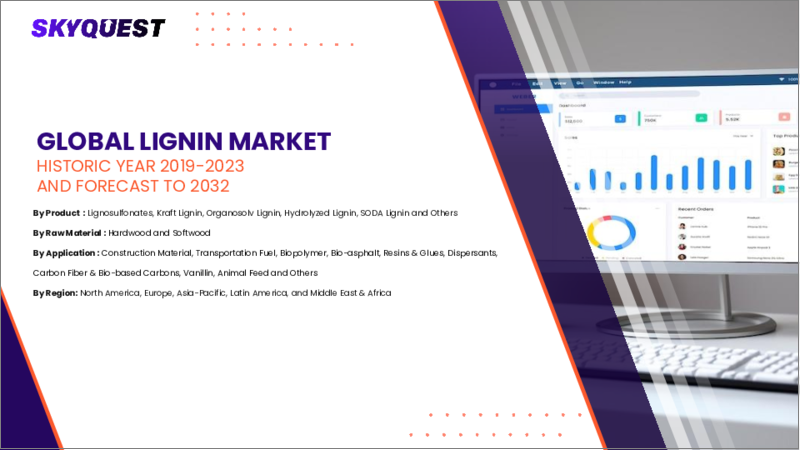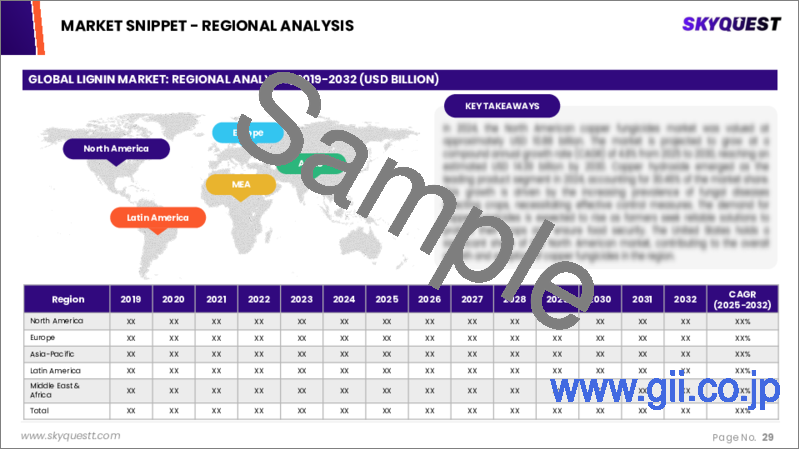|
|
市場調査レポート
商品コード
1603514
リグニンの市場規模、シェア、成長分析、製品別、用途別、地域別 - 産業予測、2024年~2031年Lignin Market Size, Share, Growth Analysis, By Product (Lignosulfonates, Kraft Lignin), By Application (Construction Materia, Transportation Fuel), By Region - Industry Forecast 2024-2031 |
||||||
|
|||||||
| リグニンの市場規模、シェア、成長分析、製品別、用途別、地域別 - 産業予測、2024年~2031年 |
|
出版日: 2024年11月26日
発行: SkyQuest
ページ情報: 英文 234 Pages
納期: 3~5営業日
|
全表示
- 概要
- 目次
世界のリグニンの市場規模は、2022年に10億1,000万米ドルとなり、2023年の11億2,000万米ドルから、2031年までには19億米ドルに成長し、予測期間(2024年~2031年)のCAGRは7.1%で成長する見通しです。
リグニンは、そのユニークな特性と数多くの利点により、さまざまな産業分野で大きな支持を得ています。豊富な官能基グループを特徴とするリグニンは、優れた生体適合性、低毒性、高炭素含有率を誇り、複合材料や炭素ベースの製品開発にとって魅力的な材料となっています。リグニンは、環境にやさしく、コストパフォーマンスに優れているため、エネルギー貯蔵、電子機器などの用途に適しています。製造分野では、リグニンはパーティクルボードや集成材製品のバインダーとして、また土壌改良材やフェノール樹脂の充填材として重要な役割を果たしています。セルロースに次いで地球上で最も豊富な有機物であるリグニンの工業的用途は、歴史的に限られており、主に燃料源として使用されてきました。しかし、リグニンの様々な成分が、石油添加剤、農薬、セメント添加剤、水処理液、繊維染料などの用途で認識されつつあるように、その可能性は燃料を超越しています。このような用途の拡大は、リグニンの多用途性を示すとともに、環境に優しい代替品を求める産業界にアピールし、持続可能な材料革新のキープレーヤーとなる可能性を示しています。リグニンをベースとした製品への関心が高まるにつれ、この市場は、様々な分野での革新と拡大のための有望な機会を提示しています。
目次
イントロダクション
- 調査の目的
- 調査範囲
- 定義
調査手法
- 情報調達
- 二次データと一次データの方法
- 市場規模予測
- 市場の前提条件と制限
エグゼクティブサマリー
- 世界市場の見通し
- 供給と需要の動向分析
- セグメント別機会分析
市場力学と見通し
- 市場概要
- 市場規模
- 市場力学
- 促進要因と機会
- 抑制要因と課題
- ポーター分析と影響
- 競争企業間の敵対関係
- 代替品の脅威
- 買い手の交渉力
- 新規参入業者の脅威
- 供給企業の交渉力
主要な市場の考察
- 主要な成功要因
- 競合の程度
- 主要な投資機会
- 市場エコシステム
- 技術の進歩
- 規制情勢
- バリューチェーン分析
- ケーススタディ分析
- 顧客と購買基準の分析
- PESTEL分析
- マクロ経済指標
- 市場の魅力指数
- 価格分析
世界のリグニンの市場規模:製品別・CAGR(2024年~2031年)
- 市場概要
- リグノスルホン酸塩
- クラフトリグニン
- オルガノソルブリグニン
- 加水分解されたリグニン
- ソーダリグニン
- その他
世界のリグニンの市場規模:用途別・CAGR(2024年~2031年)
- 市場概要
- 建設資材
- 輸送燃料
- バイオポリマー
- ポリウレタンフォーム
- その他
- バイオアスファルト
- 樹脂と接着剤
- 分散剤
- 炭素繊維・バイオベースカーボン
- バニリン
- 動物飼料
- その他
リグニン市場規模・CAGR(2024年~2031年)
- 北米
- 米国
- カナダ
- 欧州
- 英国
- ドイツ
- スペイン
- フランス
- イタリア
- その他欧州地域
- アジア太平洋
- 中国
- インド
- 日本
- 韓国
- その他アジア太平洋
- ラテンアメリカ
- ブラジル
- その他ラテンアメリカ地域
- 中東・アフリカ
- GCC諸国
- 南アフリカ
- その他中東・アフリカ
競合情報
- 上位5社の比較
- 主要企業の市場ポジショニング(2023年)
- 主要な市場企業が採用した戦略
- 市場の最近の動向
- 企業の市場シェア分析(2023年)
- 主要企業の企業プロファイル
- 会社概要
- 製品ポートフォリオ分析
- 企業のセグメント別シェア分析
- 収益の前年比比較(2021-2023)
主要企業プロファイル
- Borregaard LignoTech
- Domtar Corporation
- Stora Enso
- Rayonier Advanced Materials
- UPM Biochemicals
- Metsa Group
- Nippon Paper Industries Co., Ltd.
- West Fraser
- Aditya Birla Group
- Liquid Lignin Company LLC
- Valmet Corporation
- Domsjo Fabriker(Part of Aditya Birla)
- Green Value
- Burgo Group S.p.A.
- Sweetwater Energy
- Northway Lignin Chemical
- Asia Lignin Manufacturing Pvt. Ltd.
- Changzhou Shanfeng Chemical Industry Co. Ltd.
- The Dallas Group of America Inc.
- Schweighofer Fiber
結論と提言
Global Lignin Market size was valued at USD 1.01 billion in 2022 and is poised to grow from USD 1.12 billion in 2023 to USD 1.9 billion by 2031, growing at a CAGR of 7.1% during the forecast period (2024-2031).
Lignin has gained significant traction in various industrial sectors due to its unique properties and numerous advantages. Characterized by a rich assortment of functional groups, lignin offers excellent biocompatibility, low toxicity, and high carbon content, making it an attractive material for the development of composites and carbon-based products. Its environmentally friendly and cost-effective nature positions lignin-based materials favorably in applications such as energy storage, electronic devices, and more. In the manufacturing realm, lignin serves crucial functions as a binder in particleboard and laminated wood products, as well as a soil conditioner and a filler for phenolic resins. Ranking just behind cellulose as the most abundant organic material on Earth, lignin's industrial applications have historically been limited, primarily serving as a fuel source. However, its potential transcends fuel, as various components of lignin are increasingly recognized in applications including oil additives, agricultural chemicals, cement additives, water treatment solutions, and textile dyes. This expanding portfolio of uses illustrates lignin's versatility and showcases its potential to become a key player in sustainable material innovation, appealing to industries seeking eco-friendly alternatives. As interest in lignin-based products continues to grow, the market presents promising opportunities for innovation and expansion across multiple sectors.
Top-down and bottom-up approaches were used to estimate and validate the size of the Global Lignin market and to estimate the size of various other dependent submarkets. The research methodology used to estimate the market size includes the following details: The key players in the market were identified through secondary research, and their market shares in the respective regions were determined through primary and secondary research. This entire procedure includes the study of the annual and financial reports of the top market players and extensive interviews for key insights from industry leaders such as CEOs, VPs, directors, and marketing executives. All percentage shares split, and breakdowns were determined using secondary sources and verified through Primary sources. All possible parameters that affect the markets covered in this research study have been accounted for, viewed in extensive detail, verified through primary research, and analyzed to get the final quantitative and qualitative data.
Global Lignin Market Segmental Analysis
Global Lignin Market is segmented by Product, Application and region. Based on Product, the market is segmented into Lignosulfonates, Kraft Lignin, Organosolv Lignin, Hydrolyzed Lignin, SODA Lignin, Others. Based on application, the market is segmented into Construction Material, Transportation Fuel, Biopolymer (Polyurethane Foam, Others), Bio-asphalt, Resins & Glues, Dispersants, Carbon Fiber & Bio-based Carbons, Vanillin, Animal Feed, Others. Based on region, the market is segmented into North America, Europe, Asia Pacific, Latin America and Middle East & and Africa.
Driver of the Global Lignin Market
The global lignin market is experiencing robust growth driven by the increasing demand and supply fueled by heightened awareness of its diverse applications. Lignin can be sourced not only from high-purity materials but also from lower purity outputs generated in industries such as pulp and paper and biorefineries, enhancing its market presence. The rising availability of raw materials and simplified production processes further promote market expansion. Various extraction methods, including sulphite pulping, kraft pulping, organosolv pulping, soda pulping, and hydrolysis techniques, significantly contribute to market growth, showcasing the versatility and potential of lignin in multiple sectors.
Restraints in the Global Lignin Market
The global lignin market faces several significant restraints that may impede its growth. One of the primary challenges is the high costs linked to research and development efforts, which can limit innovation and market entry. Additionally, the trend towards constructing green buildings, where lignin is often utilized as an additive, may not be fully embraced in all regions. Furthermore, an overall lack of awareness in developing economies poses a barrier to market expansion. Other factors include price fluctuations in lignin and the elevated costs associated with its products, as well as inadequate infrastructure in low and middle-income countries, all contributing to market constraints.
Market Trends of the Global Lignin Market
The global lignin market is poised for significant growth, driven by rising investments from governments worldwide aimed at fostering research and development. This surge in funding is facilitating innovative advancements in manufacturing technology, enhancing the efficiency and sustainability of lignin production. As countries increasingly recognize lignin's potential as a renewable resource for various applications-including biofuels, bioplastics, and pharmaceuticals-the market is witnessing heightened interest from industries seeking eco-friendly alternatives. Additionally, the push towards sustainable practices further amplifies lignin's appeal, positioning it as a key player in the transition to a circular economy.
Table of Contents
Introduction
- Objectives of the Study
- Scope of the Report
- Definitions
Research Methodology
- Information Procurement
- Secondary & Primary Data Methods
- Market Size Estimation
- Market Assumptions & Limitations
Executive Summary
- Global Market Outlook
- Supply & Demand Trend Analysis
- Segmental Opportunity Analysis
Market Dynamics & Outlook
- Market Overview
- Market Size
- Market Dynamics
- Driver & Opportunities
- Restraints & Challenges
- Porters Analysis & Impact
- Competitive rivalry
- Threat of substitute
- Bargaining power of buyers
- Threat of new entrants
- Bargaining power of suppliers
Key Market Insights
- Key Success Factors
- Degree of Competition
- Top Investment Pockets
- Market Ecosystem
- Technological Advancement
- Regulatory Landscape
- Value Chain Analysis
- Case Study Analysis
- Customer & Buying Criteria Analysis
- PESTEL Analysis
- Macro-Economic Indicators
- Market Attractiveness Index
- Pricing Analysis
Global Lignin Market Size by Product & CAGR (2024-2031)
- Market Overview
- Lignosulfonates
- Kraft Lignin
- Organosolv Lignin
- Hydrolyzed Lignin
- SODA Lignin
- Others
Global Lignin Market Size by Application & CAGR (2024-2031)
- Market Overview
- Construction Material
- Transportation Fuel
- Biopolymer
- Polyurethane Foam
- Others
- Bio-asphalt
- Resins & Glues
- Dispersants
- Carbon Fiber & Bio-based Carbons
- Vanillin
- Animal Feed
- Others
Global Lignin Market Size & CAGR (2024-2031)
- North America, (Product, Application)
- US
- Canada
- Europe, (Product, Application)
- UK
- Germany
- Spain
- France
- Italy
- Rest of Europe
- Asia-Pacific, (Product, Application)
- China
- India
- Japan
- South Korea
- Rest of Asia Pacific
- Latin America, (Product, Application)
- Brazil
- Rest of Latin America
- Middle East & Africa, (Product, Application)
- GCC Countries
- South Africa
- Rest of Middle East & Africa
Competitive Intelligence
- Top 5 Player Comparison
- Market Positioning of Key Players, 2023
- Strategies Adopted by Key Market Players
- Recent Developments in the Market
- Company Market Share Analysis, 2023
- Company Profiles of All Key Players
- Company Details
- Product Portfolio Analysis
- Company's Segmental Share Analysis
- Revenue Y-O-Y Comparison (2021-2023)
Key Company Profiles
- Borregaard LignoTech
- Company Overview
- Business Segment Overview
- Financial Updates
- Key Developments
- Domtar Corporation
- Company Overview
- Business Segment Overview
- Financial Updates
- Key Developments
- Stora Enso
- Company Overview
- Business Segment Overview
- Financial Updates
- Key Developments
- Rayonier Advanced Materials
- Company Overview
- Business Segment Overview
- Financial Updates
- Key Developments
- UPM Biochemicals
- Company Overview
- Business Segment Overview
- Financial Updates
- Key Developments
- Metsa Group
- Company Overview
- Business Segment Overview
- Financial Updates
- Key Developments
- Nippon Paper Industries Co., Ltd.
- Company Overview
- Business Segment Overview
- Financial Updates
- Key Developments
- West Fraser
- Company Overview
- Business Segment Overview
- Financial Updates
- Key Developments
- Aditya Birla Group
- Company Overview
- Business Segment Overview
- Financial Updates
- Key Developments
- Liquid Lignin Company LLC
- Company Overview
- Business Segment Overview
- Financial Updates
- Key Developments
- Valmet Corporation
- Company Overview
- Business Segment Overview
- Financial Updates
- Key Developments
- Domsjo Fabriker (Part of Aditya Birla)
- Company Overview
- Business Segment Overview
- Financial Updates
- Key Developments
- Green Value
- Company Overview
- Business Segment Overview
- Financial Updates
- Key Developments
- Burgo Group S.p.A.
- Company Overview
- Business Segment Overview
- Financial Updates
- Key Developments
- Sweetwater Energy
- Company Overview
- Business Segment Overview
- Financial Updates
- Key Developments
- Northway Lignin Chemical
- Company Overview
- Business Segment Overview
- Financial Updates
- Key Developments
- Asia Lignin Manufacturing Pvt. Ltd.
- Company Overview
- Business Segment Overview
- Financial Updates
- Key Developments
- Changzhou Shanfeng Chemical Industry Co. Ltd.
- Company Overview
- Business Segment Overview
- Financial Updates
- Key Developments
- The Dallas Group of America Inc.
- Company Overview
- Business Segment Overview
- Financial Updates
- Key Developments
- Schweighofer Fiber
- Company Overview
- Business Segment Overview
- Financial Updates
- Key Developments






